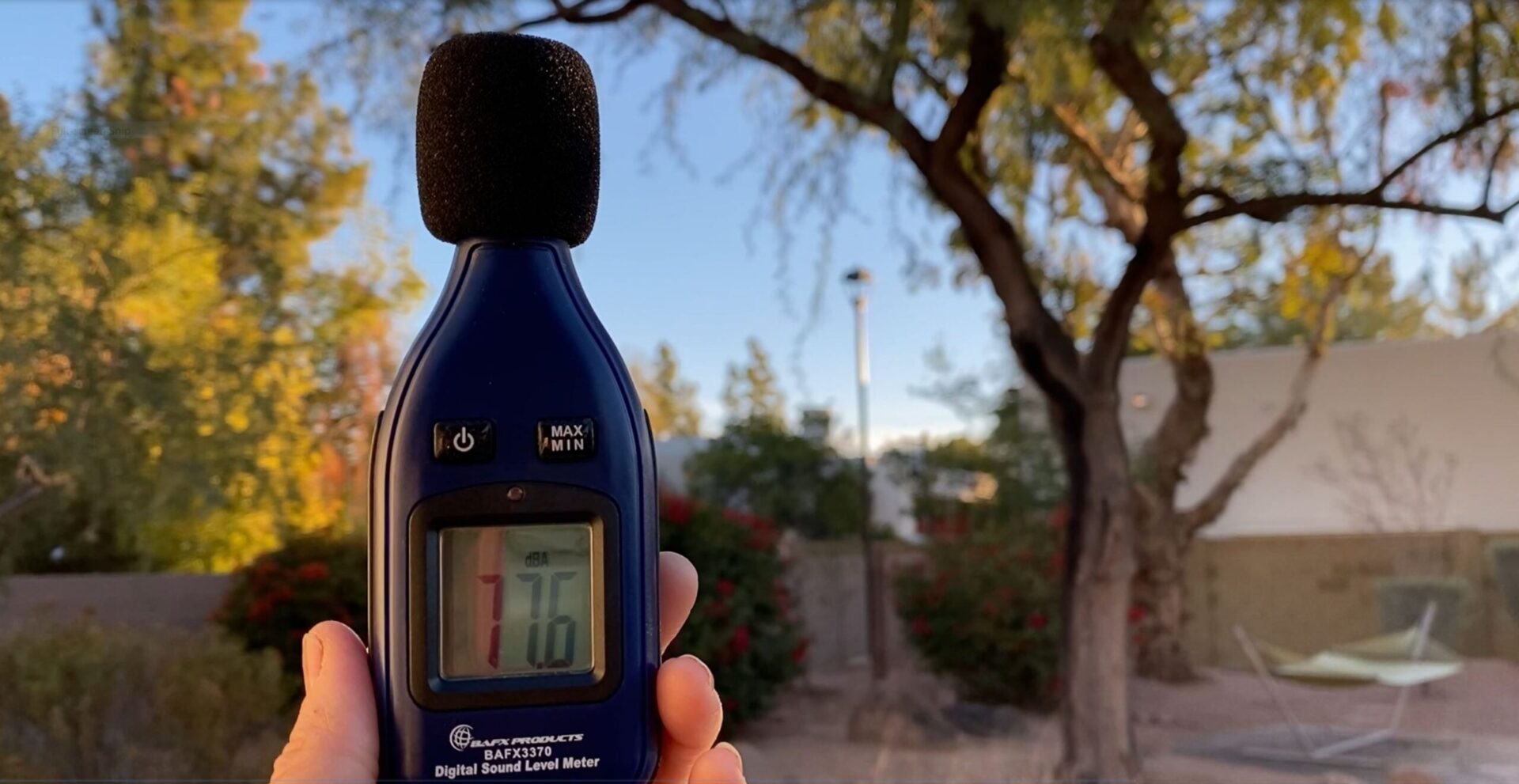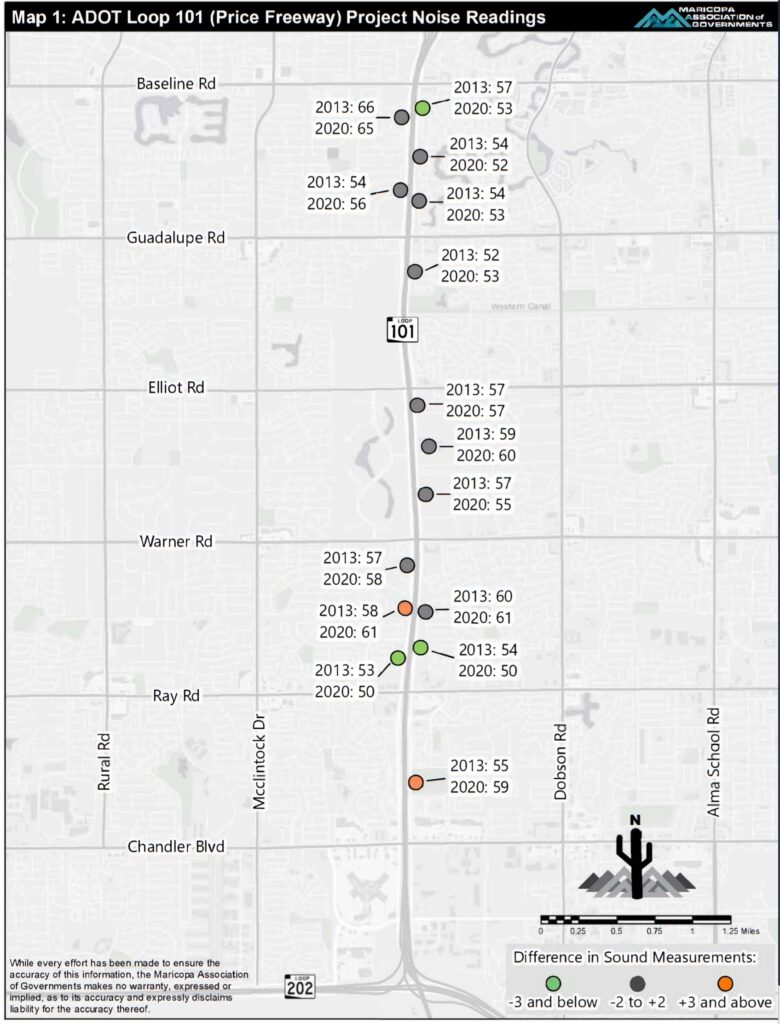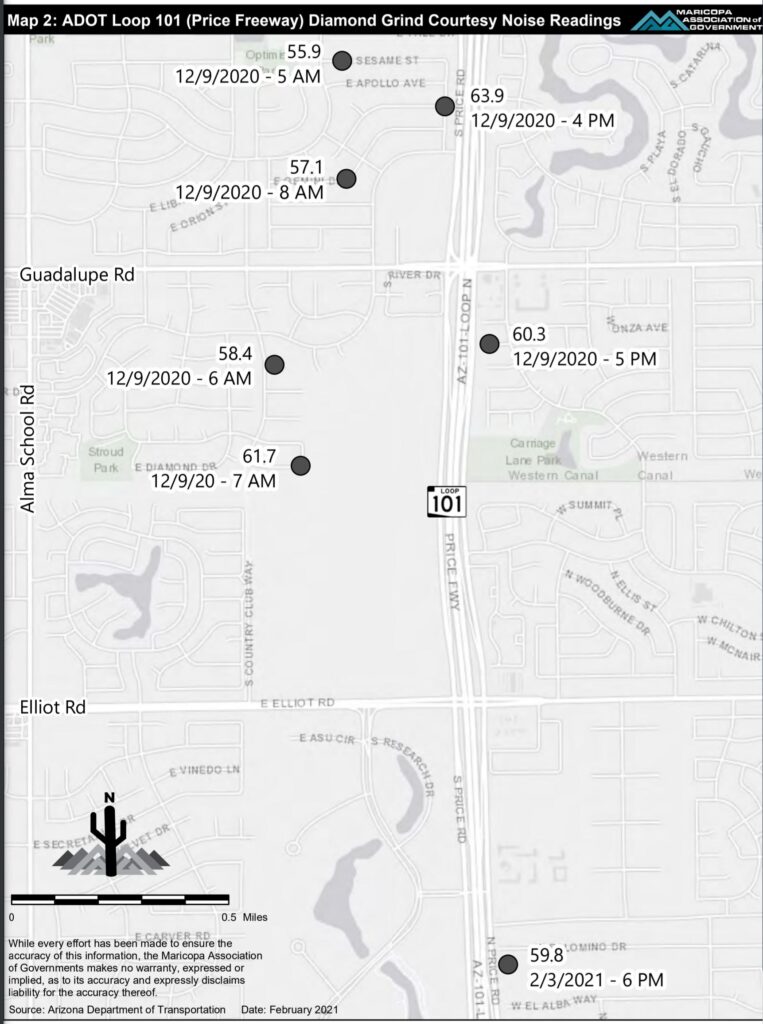
A disconnect remains between what Arizona Department of Transportation is saying and what hundreds of nearby angry neighbors are saying about noise from an experimental diamond-grinding finish on the widened Loop 101/Price Freeway through Tempe and Chandler.
The issue is to go in front of the Maricopa Association of Governments Transportation Policy Committee on Tuesday, Feb. 17, after Tempe Mayor Corey Woods requested at the Jan. 20 meeting that it be discussed.
Hundreds of residents within a half-mile of the freeway in Tempe and Chandler, who never complained about noise from the inch-thick rubberized asphalt overlay that was on the freeway before the widening, have been livid since the stretch was completed and opened to traffic last September. One sent Wrangler News a video taken in her backyard showing a reading in the mid-70-decibel range during morning rush hour.
ADOT claims that it took numerous noise readings shortly after traffic began flowing across the new surface and then three-months later took complimentary readings at homes of some who had complained. The agency said that not only were readings well within the maximum 67 decibels in federal noise-abatement guidelines but that they also were nearly identical to those on the rubberized asphalt that had broken down and was nearing its life expectancy.
According to ADOT, rubberized asphalt noise levels increase as the surface breaks down during its 10-year lifespan.
ADOT staff is expected to provide results of additional sound tests at several residences in South Tempe at the MAG meeting.
“I am very eager to hear the results of these sound tests and we understand that staff from ADOT and MAG will provide their methodology of those tests,” Woods said. “While I don’t yet know what options for next steps might be, I am committed to finding a solution and staying dedicated to this issue.”
Next steps could be tricky.
Nearly every mile in the metro Phoenix freeway system has a rubberized asphalt overlay. It was selected for its smooth ride and noise abatement. Many miles of it are approaching life expectancy and some are well beyond it already. There was no plan for paying for replacement costs, however, and at present there is no funding source identified to repave the system with rubberized asphalt.
To that, extent, it could be said that rubberized asphalt proved to be a failed experiment over time. It also could be said that better planning for replacement costs might have mitigated problems.

So MAG and ADOT last year set out to find an alternate freeway finish less expensive than rubberized asphalt and still within noise standards. In June, the MAG Regional Council, in partnership with ADOT, approved a three-year diamond-grinding pilot program.
Diamond grinding has a life span of at least 15 years. Over a 25-year period, the MAG/ADOT study found that the life-cycle costs of diamond grinding were more than $300 million lower than for rubberized asphalt for the metro Phoenix freeway system.
According to ADOT, preliminary results show that diamond grinding, in which specialized machines with diamond-tipped blades on rotating drums remove a thin layer of concrete roadway while creating small grooves to limit vehicle tire noise, is meeting ADOT’s requirements for ride quality and costs. Additionally, ADOT’s noise readings are comparable to those taken when rubberized asphalt was at the end of its useful 10-year life.
The stretch of Loop 101 from U.S. 60 to Loop 202 is the first in the Valley to use diamond grinding.
Neighbors, however, say it is diamond grinding, not rubberized asphalt, that is the failed experiment. They question the veracity and methodology of ADOT’s noise readings.
“A couple of things occurred to me: One, they probably ought to do continuous monitoring and see where these spikes are,” said Dr. Donald Boles, 68, who lives in The Oasis near Elliot Road and McClintock Drive. “If you had continuous monitoring for 24 to 72 hours, you might see some hellacious spikes in it and that would be interesting.
“And two, there are certain frequencies and certain wavelengths for certain sounds that could be a lot more irritating than others — say the difference between a flute and an electric guitar. Are they noticing that kind of a difference in irritable form than just pure decibel readings?”
Boles is an internal medicine specialist. His avocation outside of work is electronic music.
“I have a project studio in my house. I play all over the place. As a musician, I’ve played all over the country,” he said. “I know something about waves, decibels and the physics of sound. That’s why I started wondering if they just did spot checks. Was there any volume averaging done? What scale did they use? I just had a lot of questions.”
His family has lived in their two-story home since 1997. The noise is especially irritating at night when they’re trying to sleep in upstairs bedrooms.

“We certainly noticed it before everybody was talking about it,” Boles said.
He added that they had no issues with noise when rubberized asphalt covered Loop 101.
Woods said that his office has heard from at least 200 people complaining about noise from the freeway.
“Some of my colleagues are well aware that we, in Tempe, and I believe also in Chandler and in Mesa, are receiving a high number of concerns from residents who live in the neighborhoods that are directly adjacent to the 101 where the resurfacing has taken place,” Woods said at the Jan. 20 MAG Transportation Policy Committee meeting.
Phoenix Mayor Kate Gallego, who chairs the committee, agreed to the Tuesday discussion on diamond grinding, saying, “It’s an important topic to our entire region.”
Meanwhile, those near Loop 101 just want peace that would come from quiet.
“It seems to me that 200 people putting in complaints can’t all be wrong,” Boles said. “As far as I’m concerned, if they want to build a bigger wall or figure out some other way to do noise abatement, I think that would be great. I don’t know if they ever even thought this was going to be a problem.
“Obviously, they’ve got kind of a failed experiment on their hands.”
Does your business serve South Tempe or West Chandler? Wrangler News/wn.calicoeng.com advertisements get results! To purchase a print or online ad, dial 480-966-0837. Got a story idea or news tip? Give us a call at 480-966-0837.


So the project was completed during the time of a pandemic when traffic was significantly less than normal years. So measuring the noise during rush hour even three months later when the pandemic is still going strong seems ridiculous. Once we get back to a certain norm, the sound will only get worse. Just my opinion.
ADOT did a comprehensive 10 year study during their Quiet Pavement Pilot Project, and the findings showed that rubber asphalt significantly reduced the decibel level of tire noise when compared against traditional tinning and diamond ground pavement. Why, then, do they ignore their own study and go backwards?